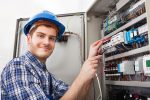An electrical panel contains several electric components that control the flow of power in a home. These include switches, circuit breakers, and subpanels.
The panels are usually found in a garage, basement, or laundry room. If your home still uses fuses, or your service is below 100 amps, you’ll want to consider upgrading your panel.
1. Circuit Breaker
The circuit breaker is an automatically managed and operated electrical switch that protects a circuit from damage caused by overload or short circuit. It works by interrupting the current flow when a fault is detected.
Look inside your service panel and you’ll see a row or two of circuit breaker switches, often labelled. Each breaker is responsible for supplying power to different areas of your home or building.
There are also push buttons and pilot lights for use by operators to control equipment or machines. It’s important to always be careful when working in an electric control panel as touching exposed wiring may cause shock.
2. Fuse
A fuse is a thin piece of metal designed to melt at a specific current or voltage. When the wire in a circuit exceeds that limit, it generates so much heat that it burns or melts, which breaks the circuit and stops the flow of electricity.
If the circuit contains delicate components that would be damaged by excessive currents, the fuse protects them by opening the circuit when the excess current flows through it. This allows the rest of the circuit to draw less than a full amp. It is a low-cost way to prevent electrical fires. It is the reason many home owners upgrade to breaker panels from single-pole fuse boxes.
3. Grounded Bus Bar
A grounding bus bar is a metal strip that provides a central point for multiple equipment ground connections. These are typically found within electrical enclosures and help dissipate electricity to earth to prevent dangerous shocks.
Brass, copper or aluminum are the preferred metals for electrical bus bars as they can conduct high currents safely and efficiently. Their shape and cross-sectional area determine their maximum amperage capacity.
A grounding bus bar is usually connected to multiple white (neutral) wires and has a green bolt on top. The purpose is to eliminate the need for separate white return wires across each load electric circuit and reduce the chances of shocks.
4. Neutral Bus Bar
A neutral bus bar is a set of screw terminals that terminate all the white ‘neutral’ wires from load circuits. It is also where the ground wires are terminated in main service panels and sub-panels.
The neutral and ground wires should never be connected together. This violates the National Electrical Code and can create a deadly situation.
The grounding wire is designed to protect the home or building occupants. Connecting it to the neutral bus bar essentially makes this conductor a live wire when it should not be. In sub-panels this is acceptable, but in the main panel it is not. A bonding jumper (green screw, metal strip, etc) is needed to separate them.
5. Grounding Bus Bar
A grounding bus bar provides a central point for equipment grounds. They’re usually made of hard-drawn electrolytic 110 alloy solid copper. They are supported on insulators or wrapped in insulation and are protected from accidental contact either by a metal earthed enclosure or elevation out of normal reach.
These bars have large surface area to handle high currents. This helps them dissipate heat efficiently and reduce losses.
The grounding bar in your panel should be attached to multiple ground wires. This creates a consistent grounding path and prevents hot wires from shorting to other devices. The grounding bar also reduces risk of shocks.
6. Enclosure
An enclosure is a metallic box that houses electric equipment. It is rated to protect against various environmental conditions including weather, dust, water and chemicals. It also includes DIN metal rails that offer a mounting structure for electric equipment and wire ducts that allow for connectivity.
This box is found in places like a garage, basement or utility closet and helps keep people from getting shocked. It should be left closed at all times, unless you are installing the Sense Home Energy monitor or making repairs to your electrical system. Otherwise, it is very dangerous to touch. Keep the panel cover closed and stand a little back while removing it.
